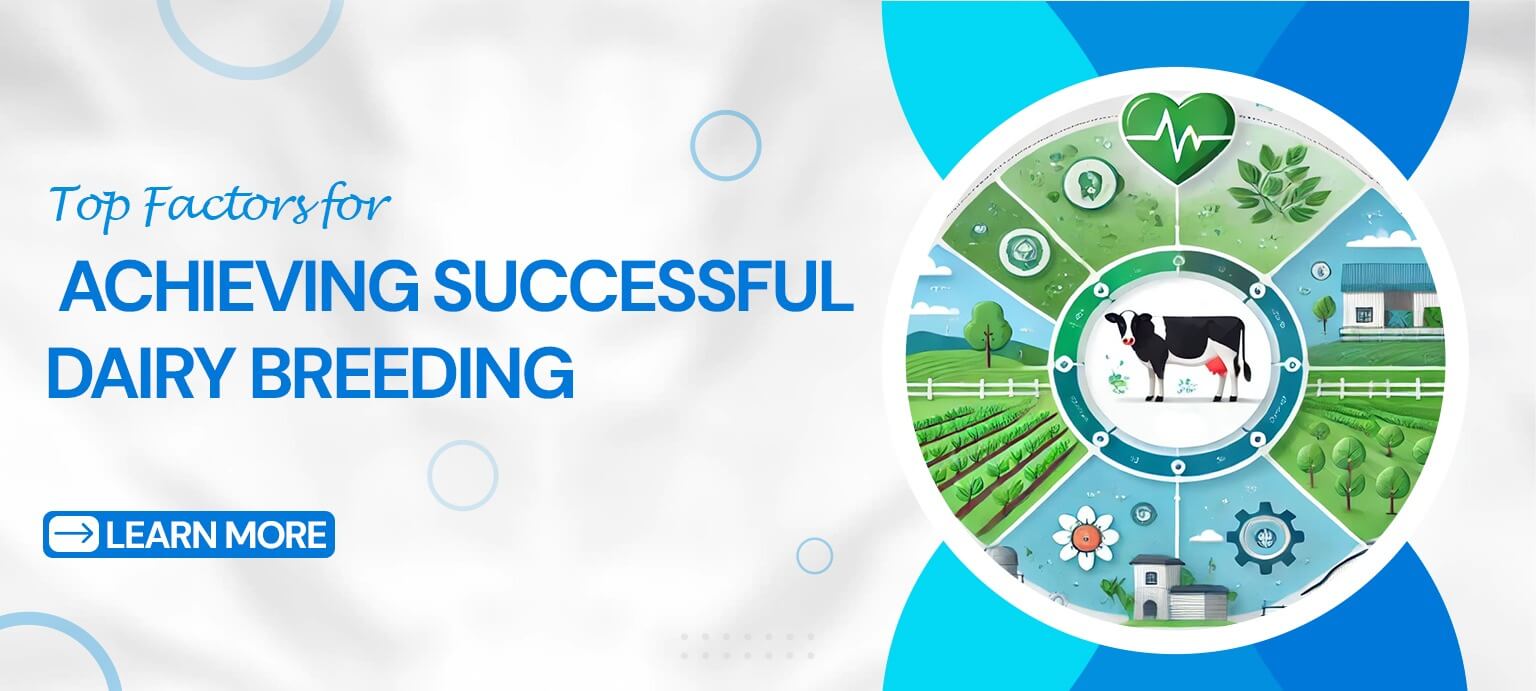Dairy breeding plays a pivotal role in enhancing milk production, improving herd genetics, and fostering overall farm profitability. For dairy farmers aiming to succeed in their breeding programs, a well-informed and strategic approach is essential. By focusing on the right factors, farmers can optimize their herd’s genetic potential and ensure consistent growth in productivity. Let’s dive into the top factors that contribute to achieving successful dairy breeding.
1) Selecting the Right Genetics for Your Herd
Genetics are the backbone of any successful dairy breeding program. Choosing the right breeding stock can drastically improve traits such as milk yield, disease resistance, and reproductive efficiency. When selecting bulls and cows for breeding, it’s important to focus on genetic lines known for their superior traits. These could include high milk production, excellent fertility rates, and good udder health.
Key Considerations for Genetic Selection:
• Production Traits: High milk yield, butterfat percentage, and protein content.
• Reproductive Traits: Fertility, calving ease, and calving interval.
• Health Traits: Disease resistance, mastitis resistance, and overall herd health.
• Longevity: Cows that can produce milk for several years without excessive health issues are ideal.
By using genetic evaluations and tools like genomic testing, you can make data-driven decisions that lead to superior breeding outcomes.
2) Effective Breeding Management
Breeding management involves proper planning and scheduling to ensure the best possible genetic match. One of the most effective ways to manage this process is through Artificial Insemination (AI). AI allows for the introduction of superior genetics into the herd without the need for live bull service, offering the ability to choose from a wide range of genetic material worldwide.
Breeding Management Tips:
• Heat Detection: Timely and accurate heat detection is essential for successful AI. Utilizing technology like automated heat detection systems can improve accuracy.
• Optimal Timing: Inseminating cows at the right time during estrus increases conception rates and reduces the number of unsuccessful breeding attempts.
• Record Keeping: Maintaining comprehensive records of mating history, calving dates, and genetics helps track breeding progress and identify trends.
3) Nutrition and Diet for Reproductive Health
Nutrition plays a critical role in the reproductive health of dairy cattle. A balanced diet ensures that cows are in peak physical condition, ready for breeding, and can maintain healthy pregnancies. A diet rich in necessary nutrients, including proteins, vitamins, and minerals, supports the cow’s ability to conceive and carry a calf to term.
Key Nutritional Considerations:
• Energy Balance: A proper energy balance is essential for fertility. Underfeeding or overfeeding can lead to reproductive issues.
• Mineral Supplementation: Minerals like calcium, phosphorus, and magnesium are vital for both reproduction and overall cow health.
• Body Condition Scoring: Monitoring the body condition of cows is important to determine if they are in optimal breeding condition. Both under-conditioned and over-conditioned cows may struggle with fertility.
4) Proper Herd Health Management
Healthy cows are more likely to conceive and produce high-quality milk. Thus, a comprehensive herd health management plan is crucial for breeding success. This includes regular health checkups, vaccination programs, and parasite control. Keeping the herd free from infections and diseases improves reproductive success and ensures high-quality milk production.
Health Management Steps for Success:
• Disease Prevention: Regular vaccinations and parasite control programs help prevent common diseases that can affect fertility, like brucellosis or mastitis.
• Preventive Care: Monitoring cows for signs of illness and providing immediate veterinary care prevents fertility problems.
• Udder Health: Mastitis prevention is especially important, as it impacts milk yield and quality.
5) Record Keeping and Data Analysis
Effective data management is a cornerstone of successful dairy breeding. Maintaining accurate records of genetics, breeding history, health data, and performance metrics allows farmers to track progress and make informed decisions. Advanced software tools and herd management systems can help dairy farmers analyze trends, predict outcomes, and optimize breeding decisions.
What to Track in Dairy Breeding Records:
• Genetic Information: Including sire and dam performance, along with the expected breeding outcomes.
• Breeding History: Dates of insemination, heat detection, and calving dates.
• Health Data: Monitoring health issues, treatments, and their potential impact on fertility.
• Milk Production: Regular milk yield data to assess the performance of different genetic lines.
6) Utilizing Technology for Precision Breeding
Technology has revolutionized the dairy breeding process, offering innovative solutions that enhance precision. From automated heat detection systems to genomic testing, technology helps farmers optimize breeding programs and increase efficiency.
Technological Tools for Breeding:
• Automated Heat Detection: Devices that monitor cow behavior and alert farmers when they are in heat, leading to more accurate timing for AI.
• Genomic Testing: This provides valuable insights into the genetic makeup of animals, enabling farmers to make precise breeding decisions.
• Software for Data Management: Digital tools that track breeding schedules, milk production, and health status for each cow in the herd.
7) Herd Replacement and Improving Genetic Lines
As part of herd management, it is crucial to gradually improve the genetic quality of the herd over time. When cows are no longer performing optimally in terms of fertility, milk production, or health, they should be replaced with younger, more productive animals. This ensures that the herd maintains its overall productivity and genetic potential.
Factors for Herd Improvement:
• Replacement Strategy: Carefully plan for the introduction of new animals that meet your farm’s specific breeding goals.
• Selective Breeding: Prioritize breeding animals with high genetic potential for desired traits, such as improved milk yield or fertility.
• Monitoring Performance: Continuously assess herd performance and replace animals that do not meet expected standards.
Final Thoughts
Achieving successful dairy breeding requires a combination of good management practices, proper nutrition, health care, and the use of advanced technology. By focusing on these key factors, dairy farmers can improve herd genetics, increase milk production, and ensure long-term profitability. Whether you are starting a new breeding program or optimizing an existing one, these strategies will guide you toward greater success in dairy farming.
If you are looking for expert guidance, advanced genetic testing, and innovative solutions to enhance your dairy breeding program, Accuvance India is here to help. With our in-depth knowledge of genetics and advanced breeding techniques, we provide tailored services that ensure optimal results for your farm. From improving herd genetics to boosting productivity, we offer comprehensive support at every step. Call us at 09310621473 to learn more about how we can help you achieve your dairy farming goals and secure a prosperous future for your farm.









